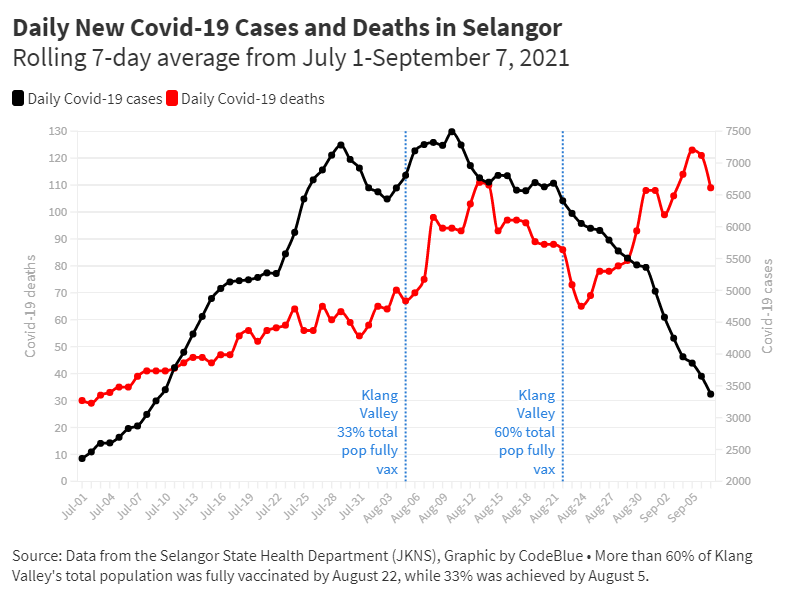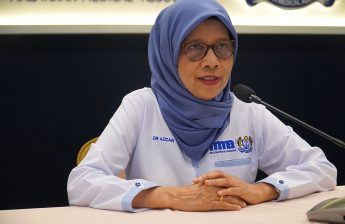KUALA LUMPUR, Sept 9 — Covid-19 fatalities increased across all districts in Selangor in the past fortnight as infections declined substantially, except Petaling district that registered a drop in deaths.
From August 25 until September 7, four districts in Malaysia’s most industrialised state reported increases in Covid-19 deaths by 100 per cent or more compared to the previous two weeks from August 11 until 24.
The four districts are Kuala Langat (355 per cent), Sepang (143.8 per cent), Klang (120.9 per cent) and Sabak Bernam (100 per cent). Sepang and Sabak Bernam, however, only comprised 3 per cent of total deaths reported in the past fortnight.
Statewide, although daily Covid-19 infections dropped 55 per cent from a high of nearly 7,500 cases on August 10 to fewer than 3,400 on September 7, based on moving averages, fatalities increased 68 per cent from 65 deaths on August 24 to 109 on September 7.
Selangor’s rise in reported deaths occurs even though nearly every adult in the Klang Valley has received double doses of Covid-19 vaccine, at least according to official statistics, while 33 per cent of the region’s total population had been fully inoculated by August 5, nearly a month ago. Public health experts told CodeBlue last month that mortality was expected to decline two weeks after 33 per cent vaccine coverage.
Hulu Langat comprised the largest proportion of the total 1,514 Covid-19 deaths in Selangor reported in the fortnight of August 25 till September 7 at 27.61 per cent, followed by Klang (25.1 per cent) and Petaling (22.46 per cent).
Gombak and Kuala Langat registered 11.62 and 6.01 per cent of Covid-19 deaths respectively in Selangor in the same period, whereas Sepang (2.58 per cent), Kuala Selangor (2.58 per cent), Hulu Selangor (1.65 per cent) and Sabak Bernam (0.40 per cent) reported less than 3 per cent of Covid-19 fatalities each.
Klang reported the highest Covid-19 deaths per capita in Selangor in that period, followed by Kuala Langat and Hulu Langat.
A total of 371.24 deaths per million people occurred in Klang from August 25 until September 7 — about 60.31 per cent higher than Selangor’s 231.57 deaths per capita. That is followed by 333.10 deaths per million people in Kuala Langat and 303.77 deaths per capita in Hulu Langat in the past fortnight.
Other districts in Selangor — Gombak (214.37), Petaling (157.26), Kuala Selangor (153.19), Sepang (151.07), Hulu Selangor (103.81) and Sabak Bernam (46.65) — reported fewer Covid-19 deaths per capita compared to the statewide average.
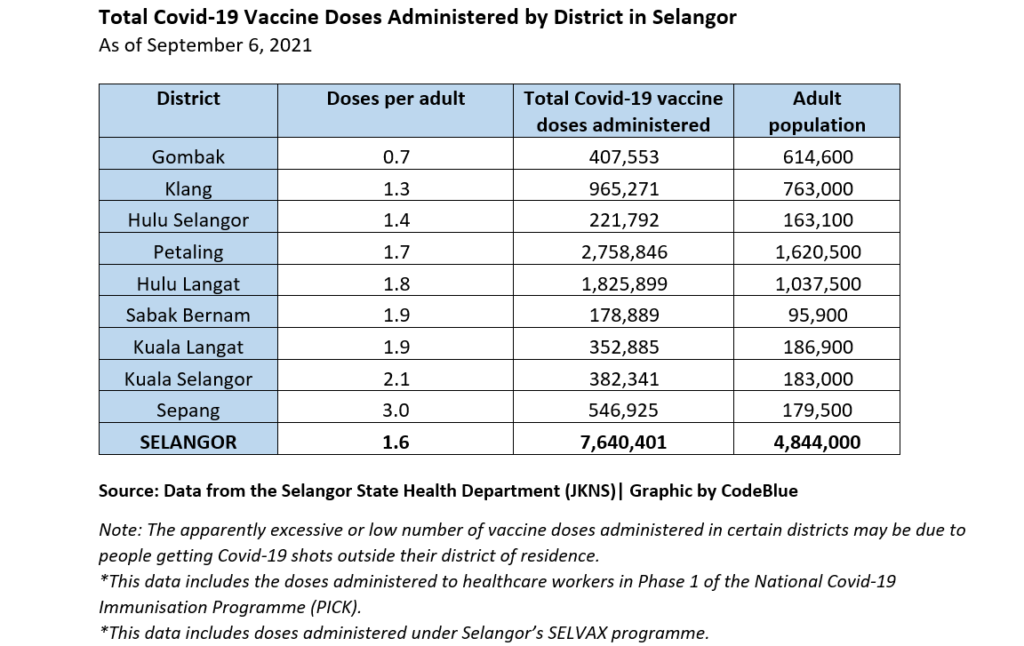
When CodeBlue looked at vaccination data to see if the districts with the steepest rise in Covid-19 deaths or the highest fatalities per capita — such as Klang, Hulu Langat, and Kuala Langat — had the lowest vaccine coverage, such links were not immediately clear as the Selangor state health department (JKNS) did not give CodeBlue the percentage of population inoculated by district in the state.
Instead, JKNS provided CodeBlue data on the number of vaccine doses administered in each vaccination centre (PPV) in every district. Hence, it is possible that the apparently excessive jabs given in Sepang and Kuala Selangor at more than two per person may be due to the inoculation of people residing outside those districts. Conversely, residents in apparently under-vaccinated districts like Gombak may have gotten their shots outside their district. All coronavirus vaccines rolled out in the Klang Valley are double-shot regimens: Pfizer-BioNTech, AstraZeneca-Oxford, and Sinovac.
Kuala Langat and Hulu Langat appeared to have high vaccine coverage at 1.9 and 1.8 doses administered per adult despite recording among the top Covid-19 deaths per capita in the past fortnight, while the purportedly under-vaccinated district of Gombak at 0.7 doses per adult recorded just a 5 per cent increase in fatalities and lower deaths per capita than the statewide average.
According to JKNS, a total of 7,640,401 doses of Covid-19 vaccine have been administered in all nine districts of the state as of September 6. On average, the adult population in Selangor has received 1.6 doses per person as of September 6.
Adults in Kuala Selangor have received an average of 2.1 doses of Covid-19 vaccine as of September 6, whereas Sabak Bernam and Kuala Langat adults have received 1.9 doses each. The adult population in Petaling and Hulu Selangor have received 1.7 and 1.4 doses respectively, while Klang adults have received 1.3 vaccine doses each.
According to the Covid-19 Immunisation Task Force (CITF), about 98 per cent of the Klang Valley adult population has been fully vaccinated to date (CITF doesn’t specify breakdowns for Selangor, Kuala Lumpur, and Putrajaya).
Dzulkefly: Deaths May Drop Soon With Declining Hospital Admissions
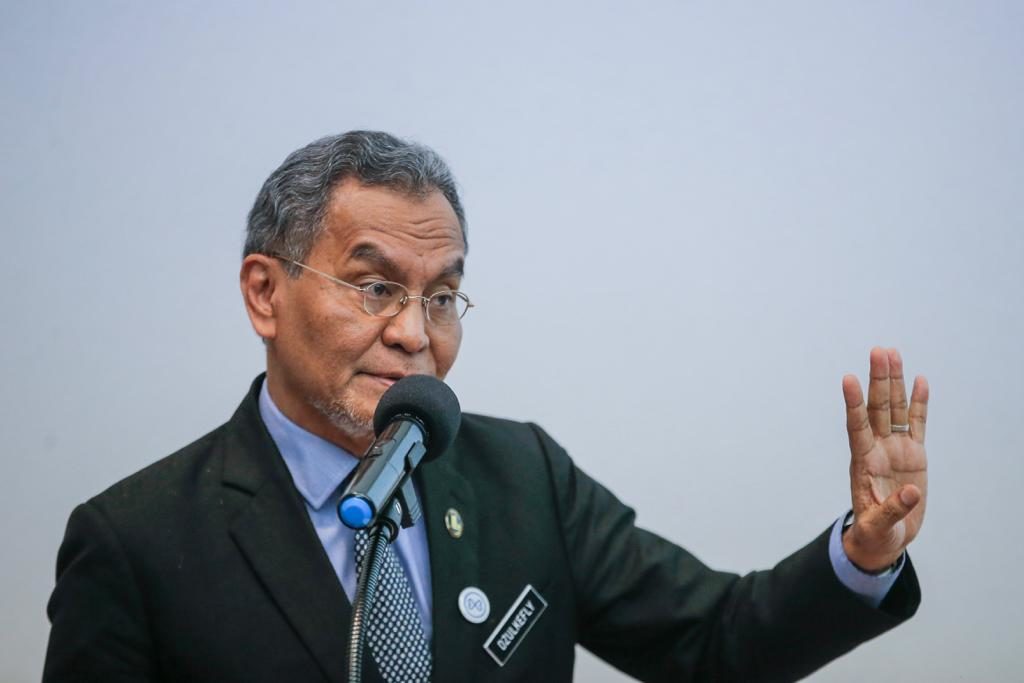
CodeBlue contacted Selangor Covid-19 Task Force chairman Dzulkefly Ahmad to learn the potential reasons for the surge in Covid-19 deaths across Selangor in the past two weeks.
According to the former health minister, Covid-19 deaths in Selangor in the past fortnight could have occurred among those who were admitted into the hospitals at least two to three weeks prior.
“I believe the Covid-19 deaths will decrease in the coming weeks as we can see a decline in Stage 3 and 4 patients in Sungai Buloh Hospital,” Dzulkefly told CodeBlue.
“I think other hospitals would also experience the same situation. So, hopefully we can see a drop in deaths soon.”
At the same time, Dzulkefly, who emphasised the need to conduct a multivariate analysis, mentioned that such analysis will clearly capture the actual reasons for the Covid-19 scenario in Selangor. A multivariate analysis studies more than one statistical outcome variable at a time.
Besides the “much expected” higher vaccination coverage in Selangor, which might have contributed to the reduction in Covid-19 cases, Dzulkefly also pointed out the possibility of under-reporting coronavirus infections in the state.
“This could also be due to under-reporting among those who are using self-test kits and not wanting to disclose results for fear of losing daily wage earned if quarantined,” he said.
“May be many unvaccinated, probably also undocumented workers are scared to come forward. Hence this could be a pandemic of the unvaccinated who contracted the virus and died. This is the case of reducing the number of the positive cases, but increasing the death numbers, in the event of their deaths.”
At the same time, Dzulkefly also noted that late medical intervention for Covid-19 patients undergoing home quarantine could also lead to an increase in deaths in Selangor.
“Very plausible that the new variants, especially the Delta variant, are highly transmissible and cause a faster spread. They could also be more pathogenic or more virulent which has led the patients to become sick quickly or deteriorate faster.
“Happy hypoxia amongst younger people is surely a possible cause for more deaths,” said Dzulkefly, referring to a condition where one may not yet feel physically out of breath although oxygen levels are dangerously low.
Klang MP: Rapid Deterioration Of Home Quarantine Cases
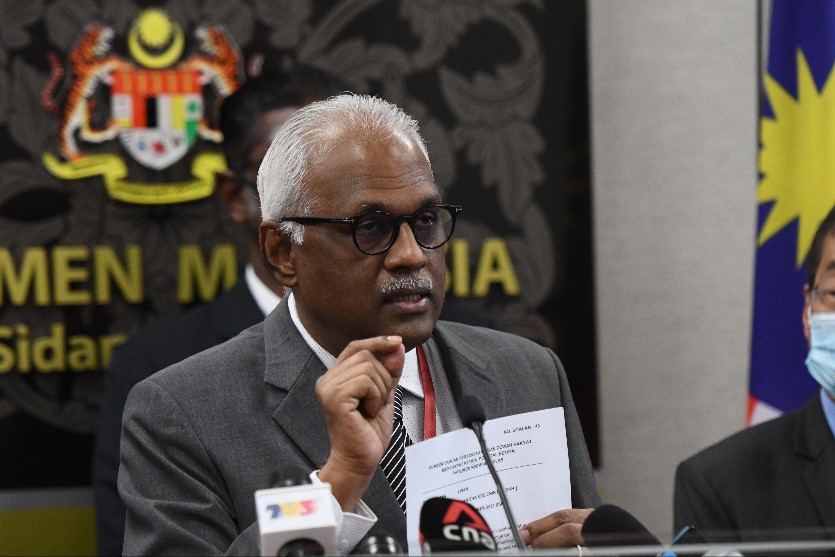
Klang MP Charles Santiago, who concurred with Dzukefly, said that ineffective isolation measures could be a reason for the rise in Covid-19 deaths when there is a decline in fresh infections.
He shared the possibility of a fraction of Covid-19 patients on home quarantine dying, as they might deteriorate faster and do not get a chance to get treatment in hospitals.
“Those who undergo home quarantine are only being consulted virtually. They might not know how to explain their health condition precisely to the doctors,” Charles told CodeBlue.
“These patients who think that they are normal might not be able to identify the slightest changes in their health condition and deteriorate suddenly.”
He also noted that not all are aware of changes in their condition, nor are people necessarily equipped with sufficient health knowledge or tools to realise worsening symptoms.
“How many of us have an oximeter at home? Not many, especially the low-income earners,” the DAP lawmaker said, referring to a tool that measures one’s oxygen levels.
Furthermore, Charles also pointed out that unidentified unvaccinated migrants and Malaysians could be a reason for the hike in Covid-19 deaths.
“We don’t know who is dying from Covid-19. Are these people vaccinated or undocumented migrants? We must find out their working class as well,” Charles added.
Health Minister Khairy Jamaluddin earlier stated that a backlog in death reports have caused Covid-19 deaths to remain high in highly vaccinated areas like the Klang Valley.
Kuala Langat — which reported the second lowest decrease (9.03 per cent) in Covid-19 cases in Selangor — registered the highest increase of Covid-19 deaths at 355 per cent in the last 14 days (August 25 until September 7) compared to the previous two weeks (August 11 until 24.)
The district reported a total of 4,685 Covid-19 cases and 91 deaths from August 25 until September 7, compared to 5,150 Covid-19 cases and 20 deaths from August 11 until 24.
Sabak Bernam reported the highest reduction in fresh Covid-19 infections in Selangor from August 25 until September 7 compared to the previous two weeks (August 11 until 24).
The least populated district in Selangor registered 238 Covid-19 cases from August 25 until September 7 — a reduction of 46.15 per cent from 442 cases in the previous 14 days.
However, the district saw a 100 per cent rise in Covid-19 deaths, from a total of three deaths (August 11-24) to six deaths (August 25-September 7).
Similarly, Hulu Langat (45.27 per cent), Kuala Selangor (43.41 per cent) and Klang (43.22 per cent) saw declines in Covid-19 cases of more than 40 per cent in the same period of time.
These three districts reported 20,775 Covid-19 cases from August 25 until September 7, compared to 37,187 cases from August 11 until 24.
During the same period, these three districts reported an increase in coronavirus-related deaths. Hulu Langat reported an increase of 40.7 per cent in Covid-19 deaths (from 297 to 418 deaths), whereas Kuala Selangor (32 to 39 deaths) and Klang (172 to 380 deaths) registered an increase of 21.9 per cent and 120.9 per cent respectively.
Petaling (29.46 per cent), Sepang (25.40 per cent), and Hulu Selangor (29.09 per cent) saw a reduction of daily Covid-19 cases of less than 30 per cent from August 25 until September 7 compared to the earlier two weeks.
These three districts reported a total of 24,870 cases — Petaling (20,454 cases), Sepang (2,873 cases), and Hulu Selangor (1,543 cases) from August 25 until September 7, compared to a total of 35,024 cases — Petaling (28,997 cases), Sepang (3,851 cases), and Hulu Selangor (2,176 cases) — from August 11 until 24.
During the same period, of these three districts, only Petaling reported a reduction in Covid-19 deaths, at 15.8 per cent, whereas the balance two districts — Sepang (143.8 per cent) and Hulu Selangor (8.7 per cent) — reported a rise in Covid-19 deaths.
Finally, from a total of 10,511 Covid-19 cases and 167 deaths from August 11 until 24, Gombak reported 10,506 cases and 176 deaths from August 25 until September 7.
That is a reduction of 0.05 per cent in fresh Covid-19 infections and an increase of 5.4 per cent in Covid-19 fatalities in the same period of time.


